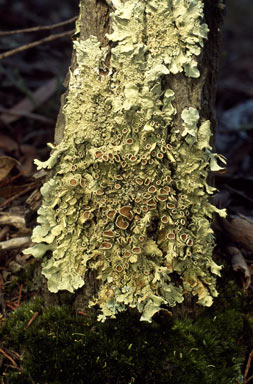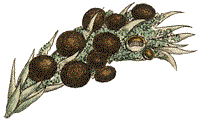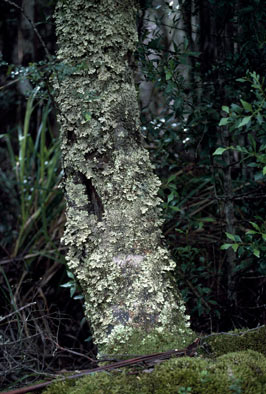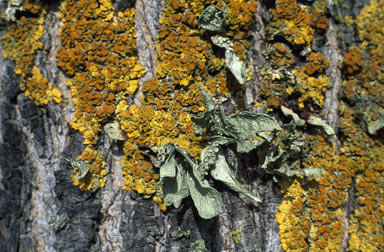Ecology
|
Lichens and plants
Some people believe that lichens that grow on trees are killing the trees. While there is still much to be learnt about the interactions between trees and lichens a century of investigation has produced no evidence to show lichens to be a major problem on trees. Of course there's more than trees to the plant kingdom and you can find lichens associating with a great variety of plants - trees, shrubs, herbs, grasses, ferns, bryophytes. The word bryophytes is the collective term for mosses, liverworts and hornworts. All of these organisms are plants and you can find out more about them on the ANBG's bryophyte website [LINK]. Looking at the plant kingdom as a whole the only general comment that can be made is that lichens may have adverse or beneficial effects on plants. In this section we'll look at some of those effects. Lichens that grow on the leaves of vascular plants are dealt with on the FOLIICOLOUS LICHENS page.
First, there is no doubt that lichen hyphae can penetrate bark:
...there may be extensive penetration of the rhizines through the cork, cortex, bast and cambium, as far as the living wood. The lichen hyphae block lenticels, split cork layers horizontally, and by increasing air exchange in the bark indirectly cause the cork cells to thicken and become more permeable to water. Small shrubs and trees densely covered with lichens could clearly be stunted and damaged
.
There is also no doubt that epiphytic lichens can have deleterious effects on the host plants. A study that compared oak twigs heavily covered by the fruticose species Evernia prunastri with lichen-free oak twigs found that leaves growing from the former had a lower chlorophyll content than leaves growing from the latter. Another study found that hyphae of Evernia prunastri could grow into the xylem vessels of host trees, so providing an entry point for lichen metabolites into the host plant![]() .
.
|
These observations could initially give the impression that lichens are terribly destructive. However, the records of any lichen-induced death or severe debility seems to be rare. Moreover, if you think for a minute you'd probably be able to recall having seen many healthy, lichen-covered trees. It is difficult to generalize about lichen penetration of bark since many factors will influence the depth of penetration. Thus far relatively few lichens have been shown to be deeply penetrating. In addition, lichens and trees have been co-existing for a long time and it's very likely that plants have developed numerous defence mechanisms to contend with physical or chemical penetration - whether by lichens or other organisms. Sure, sometimes those mechanisms fail, but there are still a lot of healthy lichen-covered trees out there. Moreover, the case of the leaf-cutter ants, mentioned on the FOLIICOLOUS LICHENS page, will give you some more food for thought as to possible benefits of lichens growing on plants![]() .
.
The term allelopathy has been used in various closely related ways, but always containing the sense of the chemical products of one organism influencing another - often the influence being harmful or inhibitory to the other organism. As noted on the CHEMISTRY page lichens produce several hundred secondary metabolites, a number of which show allelopathic properties. In this way lichens are no different to many plants and in Europe the first observation of an allelopathic effect goes back to at least classical Rome, where Varro and Pliny the Elder noticed the inhibition of plant growth around walnut trees.
A Finnish laboratory investigation deduced that compounds produced by several soil lichens in the genera Cladonia, Cetraria and Stereocaulon could have an inhibitory effect on pine and spruce seedlings. As well as publishing their laboratory findings the researchers also included anecdotal evidence in the form of a photograph that showed an area once kept free of these lichens by a tethered reindeer. In that area there were now healthy saplings around a parent tree but there were no saplings in the lichen-rich area which had been beyond the reach of the reindeer. A Canadian study showed that exudates from the terrestrial lichen Cladonia stellaris inhibited spruce growth but that removal of the lichen mats had a much worse effect on spruce growth, by worsening soil temperatures and moisture levels. This led to the conclusion that the negative effect was easily counterbalanced by the ameliorating effects that the lichen had on the soil![]() .
.
Lichen extracts have been tested on various vascular plants and a web and literature search revealed various further findings. Here are a few, just to show that there is no simple answer to the question of what lichens do to vascular plants:
- The lichen extract inhibited the growth of cucumber roots.
- The extracts inhibited the germination of wheat seeds.
- The lichen extracts demonstrated no effect.
- The compounds were stimulatory at low concentrations and inhibitory at high concentrations.
- The presence of the lichen Lecidea granulosa improves the germination of Picea maritima seeds.
- The extract stimulated the rooting of Peperomia cuttings.
Often you'll see lichens growing with bryophytes, so the two are potential competitors and a variety of lichen-bryophyte interactions do occur. Crustose lichens look like thin skins or simple washes of paint on the underlying soil, rock or wood. At first it would appear that such simple, two-dimensional growth forms could be easily overgrown by many bryophytes. In fact some crustose lichens are very effective at keeping bryophytes away, quite likely with chemical deterrents. Lichens produce a wide variety of chemical compounds, some of which have negative effects on bryophytes - acting to prevent spore germination or inhibiting protonemal or gametophytic growth![]() .
.
There is a small number of lichens which are soft and gelatinous when moist, but which dry to a hard crust. When these are found growing amongst bryophytes the dry, crusty states could easily kill the embedded bryophytes by suffocation. In the BAEOMYCES RUFUS CASE STUDY you can read about the cyclic nature of a particular bryophyte-lichen interaction. The lichen Baeomyces rufus can grow over bryophyte mats or cushions and kill them by depriving them of access to light. After a few years the lichen itself dies, decays and bryophytes can re-colonize the area. However, the lichen has produced propagules from which fresh lichens can grow in the surrounding area and this cycle continues.
We'll finish this page with two photos of lichens on healthy trees. On the left is Flavoparmelia rutidota, a species that is very common wood-inhabiting lichen through much of southern Australia. It is very common on numerous healthy native and non-Australian tree species in Canberra and is likely to be found in the majority of Canberra gardens that have mature trees with bark that is persistent and rough. The green Ramalina and orange Xanthoria in the other photo were two of many lichens found on a group of elms in the Canberra suburb of Belconnen.
 |
Flavoparmelia rutidota (left); (click to enlarge) |
![An Australian Government Initiative [logo]](/images/austgovt_brown_90px.gif)




